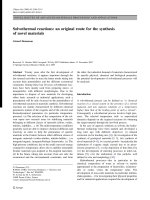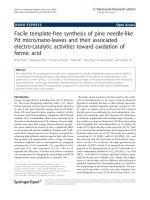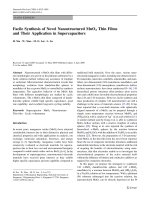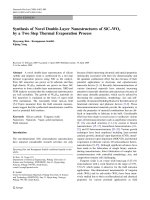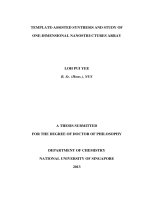Template directed synthesis of novel supramolecular architectures
Bạn đang xem bản rút gọn của tài liệu. Xem và tải ngay bản đầy đủ của tài liệu tại đây (8.94 MB, 202 trang )
TEMPLATE-DIRECTED SYNTHESIS OF NOVEL
SUPRAMOLECULAR ARCHITECTURES
SUVANKAR DASGUPTA
NATIONAL UNIVERSITY OF SINGAPORE
2012
TEMPLATE-DIRECTED SYNTHESIS OF NOVEL
SUPRAMOLECULAR ARCHITECTURES
SUVANKAR DASGUPTA
(M. Sc., Indian Institute of Technology Madras, Chennai, India)
A THESIS SUBMITTED FOR THE DEGREE OF
DOCTOR OF PHILOSOPHY
DEPARTMENT OF CHEMISTRY
NATIONAL UNIVERSITY OF SINGAPORE
2012
I
Acknowledgements
I would like to express my deep and sincere gratitude to people who have helped and
inspired me during my Ph.D. studies in the Department of Chemistry, National
University of Singapore (NUS). This thesis would not have been possible without
their firm support.
Foremost, I would like to thank my supervisor Dr. Wu Jishan for offering me the
opportunity to study in NUS and giving me continuous support during my Ph.D. study
and research. His patience, motivation, enthusiasm, and immense knowledge have
been of great value for me. He is not only an extraordinary supervisor, a complete
mentor, but also a very nice human being. I could not have imagined having a better
supervisor for my Ph.D. study.
Besides my advisor, I am deeply grateful to our collaborator, Prof. Huang Kuo-Wei
from KAUST Catalysis Center (KCC) & Division of Chemical and Life Sciences and
Engineering, Kingdom of Saudi Arabia for his kind assistance in the computational
calculations.
I would also like to thank all my past and present colleagues: Dr. Yao Junhong, Dr.
Zhang Xiaojie, Dr Yin Jun, Dr Zhao Baomin, Dr Luo Jing, Dr Luo Ding, Dr Cui
Weibin, Dr Zhang kai, Dr. Li Yuan, Dr. Zeng Lintao, Jiao Chongjun, Li Jinling, Zeng
Zebing, Sun Zhe, Mao Lu, Zhu Lijun, Zeng Wangdong, Ni Yong, Sha Zhou, Chang
Jingjing, Kam Zhiming, Luo Jie and others. They had helped me a lot not only in
chemistry but also in life.
I also want to express my appreciation to the members of instruments tests in NMR,
Mass and X-ray diffraction lab. They gave me too much help during my research
II
work. I would also like to thank all the staffs in chemistry administrative office, Lab
supplies for their immense support.
I would always remain indebted to my friends Suresh, Naresh, Abhinav, Arun,
Vinayak, Umang, Nitin, Harleen, Gujju, Prabhat, Bharti, Mohit, Madhulika, Shweta,
Nikhil, Shibajida, Animesh, Kesta, Raju, Bikram and Pasari for providing me
incredible mental support.
Last but not least, I would like to give my deepest appreciation to my parents, sister,
brother-in-law, and my cutest nephew Gullu for their love and support throughout my
studies. I am equally thankful to my partner Puja and her family for having faith in
my abilities to excel and always imbibing positivity in me. Without their presence, I
would not have been able to complete my thesis.
Above all, I thank the almighty for providing me the courage and strength to battle
with tough circumstances while doing Ph.D.
III
Thesis Declaration
The work in this thesis is the original work of SUVANKAR DASGUPTA, performed
independently under the supervision of Dr. Wu Jishan, (in the laboratory Organic
Electronics & Supramolecular Chemistry), Chemistry Department, National
University of Singapore, between August 2007 and December 2011.
The content of the thesis has been partly published in:
1) Chapter 2 - Dasgupta, S.; Wu, J. Chem. Sci. 2012, 3, 425-432.
2) Chapter 4 - Dasgupta, S.; Kuo-Wei, H.; Wu, J. Manuscript Submitted.
3) Chapter 5 - Dasgupta, S.; Wu, J. Org. Biomol. Chem. 2011, 9, 3504-3515.
Suvankar Dasgupta
04/02/2012
Name
Signature
Date
IV
Table of Contents
Table of Contents IV
Summary VIII
List of Tables X
List of Figures XI
List of Schemes XVI
List of Abbreviations XIX
Chapter 1 Introduction
1.1 Supramolecular Phenomenon 1
1.2 Self-Assembly in Biological Systems 1
1.3 Self-Assembly in Chemical Systems 2
1.3.1 Cyclodextrins 5
1.3.2 Cucurbiturils 7
1.3.3 Metal ions 7
1.3.3.1 Passive Templation 7
1.3.3.1.1 Tetrahedral Geometries 8
1.3.3.1.2 Octahedral Geometries 9
1.3.3.1.3 Square Planar Geometries 10
1.3.3.2 Active Templation 11
1.3.3.2.1 Cu
I
-Catalyzed Azide-Alkyne 1,3-Cycloaddition 11
1.3.3.2.2 Alkyne-Alkyne Couplings 12
V
1.3.4 π-Electron-Acceptor and π-Electron-Donors 13
1.3.4.1 CBPQT
4+
as π-Electron-Deficient Host 14
1.3.4.2 Crown Ethers as π-Electron-Rich Host 17
1.3.5 Amide Hydrogen Bonding 20
1.3.6 Ammonium Hydrogen Bonding 22
1.3.6.1 DBA
+
and [24]Crown Ether 24
1.3.6.2 DBA
+
and other Crown Ethers 31
1.3.6.3 R
2
NH
2
+
and [21]Crown Ethers 34
1.4 Project Objectives 36
Chapter 2 Formation of [2]Rotaxanes by Encircling [20],[21], and [22]Crown
Ethers Onto the Dibenzylammonium Dumbbell
2.1 Introduction 39
2.2 Results and Discussion
2.2.1 Synthesis of acyclic diolefin polyethers 41
2.2.2 Synthesis of [2]rotaxanes 43
2.2.3 Synthesis of cyclic polyethers 49
2.2.4 Generation of pseudo[2]rotaxanes 50
2.3 Conclusions 64
2.4 Experimental Section
2.4.1 Materials and methods 65
2.4.2 X-ray crystallographic analysis 66
2.4.3 Synthetic procedures and characterization data 68
Chapter 3 Is It Possible to Generate [2]Rotaxanes by Clipping [19]Crown Ethers
Onto The Dibenzylammonium Dumbbell?
3.1 Introduction 79
VI
3.2 Results and Discussion
3.2.1 Substrate scope
3.2.1.1 Choice of dumbbells 81
3.2.1.2 Choice of acyclic diolefin polyether 84
3.2.2 RCM reactions 87
3.3 Conclusion 95
3.4 Experimental Section
3.4.1 Materials and methods 95
3.4.2 Synthetic procedures and characterization data 96
Chapter 4 Trifluoromethyl as Stopper for a [2]Rotaxane Encircled with a
[20]Crown Ether
4.1 Introduction 99
4.2 Results and Discussion
4.2.1 Synthesis of salts 101
4.2.2 Synthesis of 20C6 and 20C6H
2
102
4.2.3 Synthesis of [2]rotaxanes by ring-closing-metathesis 103
4.2.4 Kinetic stability of [2]rotaxane 4-14·BAr
4
109
4.3 Conclusion 113
4.4 Experimental Section
4.4.1 Materials and methods 114
4.4.2 Synthetic procedures and characterization data 115
Chapter 5 Template-Directed Synthesis of Kinetically and Thermodynamically
Stable Molecular Necklace using Ring Closing Metathesis
5.1 Introduction 119
5.2 Results and Discussion
VII
5.2.1 Synthesis of key intermediates 5-5, 5-13 and 5-19 123
5.2.2 Synthesis of threads 5-1 (PF
6
)
4
and 5-2 (PF
6
)
6
125
5.2.3 Synthesis of [5]molecular necklace 5-23 (PF
6
)
4
126
5.2.4 Characterization of [5]molecular necklace 5-23 (PF
6
)
4
129
5.2.5 Attempted synthesis of [7]molecular necklace 136
5.3 Conclusion 137
5.4 Experimental Section
5.4.1 Materials and methods 138
5.4.2 Synthetic procedures and characterization data 138
Chapter 6 Conclusion and Outlook 153
References 158
VIII
Summary
This thesis described the ability of the dibenzylammonium ion to be encircled
with crown ethers having less than 24 atoms. It also highlighted the affectivity of a
small trifluoromethyl group to act as stopper in a [2]rotaxane interlocked with
[20]crown ether. The synthesis of a well-defined, homogeneous, kinetically and
thermodynamically stable [5]molecular necklace has also been discussed.
Chapter 1 presents a brief overview of the supramolecular phenomenon existing in
nature and harnessing the same in chemical systems to obtain inclusion complexes.
The journey from inclusion complexes to the mechanically interlocked structures with
particular emphasis on the template-directed synthesis of mechanically interlocked
structures has been described. The plethora of complimentary synthons available for
constructing mechanically interlocked structures has been described briefly except for
ammonium-crown ether synthons whose progress is discussed much more elaborately.
In chapter 2, the synthesis of [2]rotaxanes with dibenzylammonium ion dumbbell
and [20]-, [21]-, [22]crown ethers will be described. The generation of 1:1
pseudo[2]rotaxanes by threading dibenzylammonium ion dumbbell with [23]crown
ethers will also be discussed.
In chapter 3, the attempts to synthesize [2]rotaxane on dibenzylammonium ion
motif by encircling [19]crown ether has been described. The choice of different
dumbbells and acyclic diolefin polyethers for this purpose has been properly
reasoned.
In chapter 4, the clipping of [20]crown ether on dialkylammonium and N-
benzylalkylammonium dumbbells have been described. The successful synthesis and
IX
isolation of [2]rotaxane on N-benzylalkylammonium dumbbell having trifluoromethyl
stopper group and [20]crown ether macrocycle will be discussed.
In chapter 5, the synthesis of a well-defined, homogeneous, kinetically and
thermodynamically stable [5]molecular necklace utilizing “threading-followed-by-
ring-closing-metathesis” protocol will be described. The careful choice and synthesis
of a thread containing four dibenzylammonium ions with olefin at both ends will be
described whose threading with excess DB24C8 followed with ring closing
metathesis will be discussed.
X
List of Tables
Table 2.1 Effect of solvent system on the association constants K
a
of the
pseudorotaxane species 2-9f PF
6
at 300 K. 57
Table 2.2 Effect of solvent system on the association constants K
a
of the
pseudorotaxane species 2-9e PF
6
at 300 K. 61
XI
List of Figures
Figure 1.1 Conceptual approaches for the synthesis of a [2]rotaxane. 4
Figure 1.2 Molecular structure of β-cyclodextrin-based [2]rotaxanes. 6
Figure 1.3 Molecular structure of tetrahedral Cu
I
[2]rotaxanes. 9
Figure 1.4 Molecular structure of rotaxanes based on octahedral geometries. 10
Figure 1.5 Molecular structure of rotaxanes based on square planar geometries. 11
Figure 1.6 Molecular structure and catalyic cycle for rotaxane formation based
on CuAAC template reaction. 12
Figure 1.7 Molecular structure of rotaxanes synthesized by alkyne-alkyne
homocoupling. 13
Figure 1.8 Structure of pseudo[2]rotaxane obtained from paraquat
dication and BPP34C10. 13
Figure 1.9 Structure of pseudo[2]rotaxane obtained from
hydroquinone and CBPQT
4+
. 14
Figure 1.10 Molecular structure of rotaxane with CBPQT
4+
host. 16
Figure 1.11 Molecular structure of rotaxane with BPP34C10 host. 17
Figure 1.12 Structure of pseudo[2]rotaxane obtained from
EtO
2
Cpy(CH
2
)
2
pyCO
2
Et and DB24C8. 18
Figure 1.13 Molecular structure of rotaxane based on DB24C8-BPE self-assembly. 18
Figure 1.14 Structure of pseudo[2]rotaxane obtained from paraquat
and BMP32C10-based cryptand. 19
Figure 1.15 Molecular structure of rotaxane based on paraquat/BMP32C10-based
cryptand self-assembly. 19
XII
Figure 1.16 Host-Guest interactions between p-benzoquinone and tetralactam
macrocycle. 20
Figure 1.17 Face-to-face complexation between the crown ethers and
ammonium ions. 23
Figure 1.18 Structure and formation of pseudo[2]rotaxane from
DB24C8and DBA. 23
Figure 1.19 Molecular structure of rotaxane based on the self-assembly of
DB24C8 and DBA. 25
Figure 1.20 Molecular structures of different 24C8 macrocycle. 28
Figure 1.21 Structure of polypseudorotaxanes based on the self-assembly of
DB24C8 and DBA. 29
Figure 1.22 Molecular structure of poly[n+1]rotaxanes based on the self-assembly
of DB24C8 and DBA. 30
Figure 1.23 Structure of pseudo[2]rotaxane obtained from BMP25C8 and DBA. 32
Figure 1.24 Structure of pseudo[2]rotaxane obtained from TB27C9 and
(p-CO
2
Me)
2
-DBA. 32
Figure 1.25 Molecular structure of rotaxane based on DB30C10 and DBA. 33
Figure 1.26 Structure of pseudo[3]rotaxane obtained from BMP32C10 and DBA. 33
Figure 1.27 Molecular structure of BPP34C10, TPP51C15, TPP68C20 and
their pseudorotaxanes formed with DBA. 34
Figure 2.1 Structure of [2]rotaxane involving DBA-based dumbbell
interlocked with [24]crown-6 macrocycle. 40
Figure 2.2 Structure of [2]rotaxane incorporating [21]crown-7 macrocycle. 40
Figure 2.3 Partial
1
H NMR spectra showing decomposition of 2a. 44
Figure 2.4
1
H NMR spectra of [2]rotaxanes 2-8b PF
6
, 2-8c PF
6
and 2-8d PF
6
. 45
Figure 2.5
1
H NMR spectra of [2]rotaxanes 2-9b PF
6
, 2-9c PF
6
and 2-9d PF
6
. 46
XIII
Figure 2.6 Capped stick representation of the crystallographic structure of
[2]rotaxanes 2-8b PF
6
, 2-8c PF
6
, 2-8d PF
6
and 2-9c PF
6
. 47
Figure 2.7 Space-filling representation of the crystallographic structure of
[2]rotaxanes 2-8b PF
6
, 2-8c PF
6
, 2-8d PF
6
and 2-9c PF
6
. 48
Figure 2.8 Stacked
1
H NMR spectra of 1-1 PF
6
, pseudo[2]rotaxane 2-8f PF
6
and cyclic polyether 2-10f. 51
Figure 2.9 Low resolution ESI-MS spectrum of 2-8f PF
6
. 52
Figure 2.10 Stacked
1
H NMR spectra of 2-8f PF
6
in different solvents. 53
Figure 2.11 Capped stick and space-filling representation of the crystallographic
structure of 2-8f PF
6
. 54
Figure 2.12 Stacked
1
H NMR spectra of 1-1 PF
6
, pseudo[2]rotaxane 2-9f PF
6
and cyclic polyether 2-11f. 55
Figure 2.13 Low resolution ESI-MS spectrum of 2-9f PF
6
. 56
Figure 2.14 Stacked
1
H NMR spectra of 2-9f PF
6
in different solvents. 56
Figure 2.15 Capped stick and space-filling representation of the crystallographic
structure of 2-9f PF
6
. 57
Figure 2.16 Stacked
1
H NMR spectra of 1-1 PF
6
, pseudo[2]rotaxane 2-9e PF
6
and cyclic polyether 2-11e. 59
Figure 2.17 Low resolution ESI-MS spectrum of 2-9e PF
6
. 59
Figure 2.18 Stacked
1
H NMR spectra of 2-9e PF
6
in different solvents. 60
Figure 2.19 Partial
1
H NMR spectra of 2-9d PF
6
at various temperatures. 62
Figure 2.20 Partial
1
H NMR spectra of 2-9b PF
6
at various temperatures. 63
Figure 2.21 Partial
1
H NMR spectra of 2-9c PF
6
at various temperatures. 64
Figure 3.1 Molecular structures of dumbbells 1-1 PF
6
, 3-1 PF
6
, 3-2 BAr
4
and 3-3 PF
6
. 82
XIV
Figure 3.2 Stacked partial
1
H NMR spectra of 1-1 PF
6
, 3-1 PF
6
, 3-2 BAr
4
and 3-3 PF
6
. 83
Figure 3.3 Molecular structures of acyclic diolefin polyethers 3-6 and 3-7. 84
Figure 3.4
1
H NMR spectrum of compound 3-6 with peaks assigned. 86
Figure 3.5
1
H NMR spectrum of compound 3-7 with peaks assigned. 86
Figure 3.6 Low-resolution ESI-MS spectrum of the RCM reaction between
3-1 PF
6
and 3-6. 87
Figure 3.7 Low-resolution ESI-MS spectrum of the RCM reaction between
3-2 BAr
4
and 3-6. 89
Figure 3.8 Low-resolution ESI-MS spectrum of the RCM reaction between
3-3 PF
6
and 3-6. 90
Figure 3.9 Low-resolution ESI-MS spectrum of the RCM reaction between
1-1 PF
6
and 3-7. 91
Figure 3.10 Low-resolution ESI-MS spectrum of the RCM reaction between
3-1 PF
6
and 3-7. 93
Figure 3.11 Low-resolution ESI-MS spectrum of the RCM reaction between
3-3 PF
6
and 3-7. 94
Figure 4.1 Stacked partial
1
H NMR spectra of 4-1 PF
6
and a 1:1 mixture
of 4-1 PF
6
and DB24C8. 99
Figure 4.2 Stacked partial
1
H NMR spectra to appreciate pseudo[2]rotaxane
4-2 PF
6
formation from 4-1 PF
6
and B21C7. 100
Figure 4.3 Molecular structures of rotaxane containing B21C7 and 21C7. 101
Figure 4.4 Low-resolution ESI-MS spectrum of the RCM reaction between
4-1 PF
6
and 2-2b. 104
Figure 4.5 Stacked partial
1
H NMR spectra displaying the increase in
acidity in dumbbells 4-1→4-5→4-6. 105
XV
Figure 4.6 Low-resolution ESI-MS spectrum of the RCM reaction between
4-5 BAr
4
and 2-2b. 106
Figure 4.7 Stacked
1
H NMR spectra of 4-6 BAr
4
and 4-14 BAr
4
. 107
Figure 4.8 High-resolution ESI-MS spectrum of the [2]rotaxane 4-14 BAr
4
. 108
Figure 4.9 2D NOESY
1
H NMR spectrum of 4-14 BAr
4
in CDCl
3
. 109
Figure 4.10 Stacked
1
H NMR spectra showing the decay of 4-14 BAr
4
with time. 110
Figure 4.11 Plot of logarithmic concentration value (lnC) of 4-14 BAr
4
with time. 111
Figure 4.12 Stacked
1
H NMR spectra showing the effect of temperature on
4-14 BAr
4
. 112
Figure 4.13 Capped stick and space-filling representation for the calculated
structure of [2]rotaxane 4-14 BAr
4
. 113
Figure 5.1 Molecular structure of threads 5-1 (PF
6
)
4
and 5-2 (PF
6
)
6
. 122
Figure 5.2
1
H NMR spectra of 5-1 (PF
6
)
4
and 5-23 (PF
6
)
4
. 130
Figure 5.3 Variable temperature
1
H NMR spectra of 5-23 (PF
6
)
4
. 131
Figure 5.4
1
H-
1
H COSY NMR spectrum of 5-23 (PF
6
)
4
. 133
Figure 5.5 NOESY
1
H NMR spectrum of 5-23 (PF
6
)
4
. 134
Figure 5.6 ESI-MS spectrum for 5-23 (PF
6
)
4
showing the isotopic
distribution of the major peaks. 135
XVI
List of Schemes
Scheme 1.1 Preparation of cyclodextrin-based [2]rotaxanes with metalloorganic
stoppers using a threading-followed-by-stoppering procedure. 6
Scheme 1.2 Preparation of CB[6]-based [2]rotaxane by
threading-followed-by-stoppering approach. 7
Scheme 1.3 Synthesis of the first metal template [2]rotaxane by metal-directed
threading-followed-by-stoppering approach. 8
Scheme 1.4 Synthesis of [2]rotaxane based on donor-acceptor interactions
both by threading-followed-by-stoppering and clipping method. 15
Scheme 1.5 Synthesis of [2]rotaxanes directed by the amide hydrogen
bonding using the threading-followed-by-stoppering method. 21
Scheme 1.6 Schematic representation for the formation of [2]rotaxane
by clipping method, which involved condensation between
isophthaloyl chloride and p-xylylene diamine. 22
Scheme 1.7 Formation of [2]rotaxane 1-6 PF
6
by
threading-followed-by-stoppering method. 24
Scheme 1.8 Formation of [2]rotaxane 1-16 PF
6
by reducing the equilibrium
mixture containing imine-stoppered-[2]rotaxane 1-15 PF
6
. 25
Scheme 1.9 Formation of [2]rotaxane 1-22 PF
6
by clipping methodology
employing reversible imine condensation. 27
Scheme 1.10 Synthesis of [2]rotaxane 1-24 PF
6
by RCM of compound 1-23 in
presence of 1-20 PF
6
. 27
XVII
Scheme 1.11 Synthesis of branched [4]rotaxanes 1-36 (PF
6
)
3
, 1-37 (PF
6
)
3
and
1-38 (PF
6
)
3
by reversible imine-clipping methodology of compound. 31
Scheme 1.12 Synthesis of [2]rotaxane 1-48 PF
6
by
threading-followed-by-stoppering method. 35
Scheme 1.13 Synthesis of [2]rotaxane 1-51 BF
4
by
threading-followed-by-stoppering method. 35
Scheme 1.14 Synthesis of hetero[3]rotaxane 1-54 (PF
6
)
2
by
threading-followed-by-stoppering method. 35
Scheme 2.1 Synthetic route to acyclic diolefin polyethers 2-(2a-f). 42
Scheme 2.2 Synthetic route to a series of [2]rotaxanes, 2-(8b-d) PF
6
and
2-(9b-d) PF
6
. 43
Scheme 2.3 Synthetic route to cyclic polyethers 2-(10e-f) and 2-(11e-f). 50
Scheme 2.4 Generation of pseudo[2]rotaxane 2-8f PF
6
. 50
Scheme 2.5 Generation of pseudo[2]rotaxane 2-9f PF
6
. 54
Scheme 2.6 Generation of pseudo[2]rotaxane 2-9e PF
6
. 58
Scheme 3.1 Synthesis of 3-2 BAr
4
by protonation followed by counter
ion exchange. 82
Scheme 3.2 Synthesis of compound 3-6 from tetraethylene glycol
and 1,4-diiodobutane. 84
Scheme 3.3 Synthesis of compound 3-7 by etherification of compound 3-9
under refluxing condition with compound 3-8. 85
Scheme 4.1 Synthetic route to 4-5 BAr
4
and 4-6 BAr
4
. 102
Scheme 4.2 Synthetic route to 20C6 4-7 and 20C6H
2
4-8. 102
Scheme 4.3 Synthetic route to [2]rotaxanes 4-12 PF
6
, 4-13 BAr
4
, and
4-14 BAr
4
. 103
XVIII
Scheme 5.1 Synthesis of [4]MN from the quantitative self-assembly of
nine species. 120
Scheme 5.2 Synthesis of [5]MN by the 2+2 approach through
incorporation of Cu
2+
ions. 120
Scheme 5.3 Synthesis of [6]MN facilitated by strong host-stabilized
charge transfer interactions within the cavity of CB[8]. 121
Scheme 5.4 Synthetic route to key intermediate 5-5. 123
Scheme 5.5 Synthetic route to key intermediates 5-13 and 5-19. 124
Scheme 5.6 Synthetic route to threads 5-1 (PF
6
)
4
and 5-2 (PF
6
)
6
. 125
Scheme 5.7 Synthetic route to [5]MN 5-23 (PF
6
)
4
. 126
Scheme 5.8 Attempted threading of 5-2 (BPh
4
)
6
. 136
XIX
List of Abbreviation
19C5 [19]crown-5
20C6 [20]crown-6
20C6H
2
[20]crown-6 saturated
21C6 [21]crown-6
21C6H
2
[21]crown-6 saturated
21C7 [21]crown-7
22C6 [22]crown-6
22C6H
2
[22]crown-6 saturated
23C6 [23]crown-6
23C6H
2
[23]crown-6 saturated
23C7 [23]crown-7
23C7H
2
[23]crown-7 saturated
24C6 [24]crown-6
24C8 [24]crown-8
Ar Aryl
B21C7 Benzo[21]crown-7
B24C8 Benzo[24]crown-8
BAr
4
tetrakis[3,5-
bis(trifluoromethyl)phenyl]borate
Boc tert-butoxycarbonyl
BPE 1,2-bis(pyridinium)ethane
BMP25C8 Benzo(m-phenylene)[25]crown-8
XX
BMP26C8 bis(m-phenylene)-26-crown-8
BMP32C10 bis(m-phenylene)-32-crown-10
BPP34C10 bis-p-phenylene-34-crown-10
Bpy 2,2’-bipyridine
CB Cucurbiturils
CBPQT
4+
Cyclobis(paraquat-p-phenylene)
cyclophane
CDCl
3
Deuterated chloroform
CD
3
CN
Deuterated acetonitrile
C
2
D
2
Cl
4
Deuterated tetrachloroethane
CHCl
3
Chloroform
COSY Correlated spectroscopy
DB18C6 Dibenzo[18]crown-6
DB24C8 Dibenzo[24]crown-8
DB30C10 Dibenzo[30]crown-10
DBA
+
Dibenzylammonium ion
DCC Dynamic covalent chemistry
DCM Dichloromethane
DMF Dimethylformamide
DMSO Dimethylsulfoxide
DMSO-d
6
Deuterated dimethylsulfoxide
DNP 1,5-dioxynaphthalene
DP24C8 Dipyrido[24]crown-8
Dpp 2,9-diphenyl-1,10-phenanthroline
EA Ethyl acetate
XXI
ESI-MS Electrospray ionization mass spectrum
HCl Hydrochloric acid
HRMS High resolution mass spectrum
LAH Lithium aluminum hydride
MeOH Methanol
MIM Mechanically interlocked molecules
MN Molecular Necklace
MSS Mixture solvent system
NMR Nuclear magnetic resonance
NOESY Nuclear Overhauser Enhancement
Spectroscopy
Ph Phenyl
PEG Polyethyleneglycol
P24C8 Pyrido[24]crown-8
[2]R [2]rotaxane
RCM Ring-closing-metathesis
RNA Ribonucleic acid
R
2
NH
2
+
Secondary alkylammonium ions
t-Bu tert-butyl
TB24C8 Tetrabenzo[24]crown-8
TB27C9 Tribenzo[27]crown-9
TEA Triethylamine
TFA Trifluoroacetic acid
THF Tetrahydrofuran
TLC Thin layer chromatography
XXII
TPP51C15 Tris(p-phenylene)[51]crown-15
TPP68C20 Tetrakis(p-phenylene)[68]crown-20
TMS Tetramethylsilane
TMV Tobacco mosaic virus
Chapter 1 Introduction
1
CHAPTER 1
INTRODUCTION
1.1 Supramolecular Phenomenon
Living organisms are built of highly organized assemblies of organic molecules
performing very efficiently specific tasks of enormous complexity. These assemblies
are characterized by high level of organization and considerable mobility. These
organizations are governed by molecular recognition, self-organization and self-
assembly. The molecular recognition is a process which involves selective binding of
one substrate out of many available substrates by a given receptor molecule. This
selectivity is achieved by various weak intermolecular interactions such as hydrogen
bonding, ion-ion, ion-induced dipole, dipole-dipole, π-π stacking and van der Waals
interactions. For the selective and effective binding of substrate molecule, the receptor
molecule often has to undergo conformational change which is known as self-
organization. The molecular recognition of the substrate by the receptor induces self-
organization of the receptor, which makes it feasible for the substrate and the receptor
to assemble together in a manner that enhances the favourable weak intermolecular
interactions, consequently lowering the energy of the assembled species. This
phenomenon is known as self-assembly, which is probably responsible for the
emergence of life. The molecular recognition, self-organization and self-assembly
together constitute supramolecular phenomenon, and the assemblies formed as a
result are known as supramolecular assemblies.
1.2 Self-Assembly in Biological Systems
